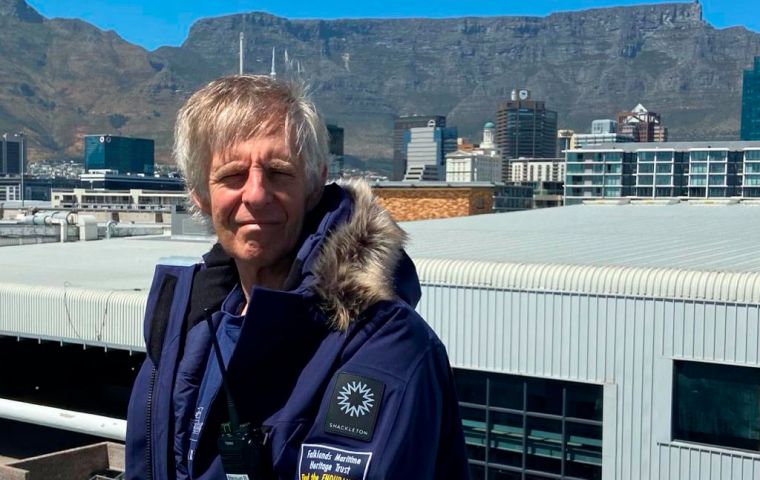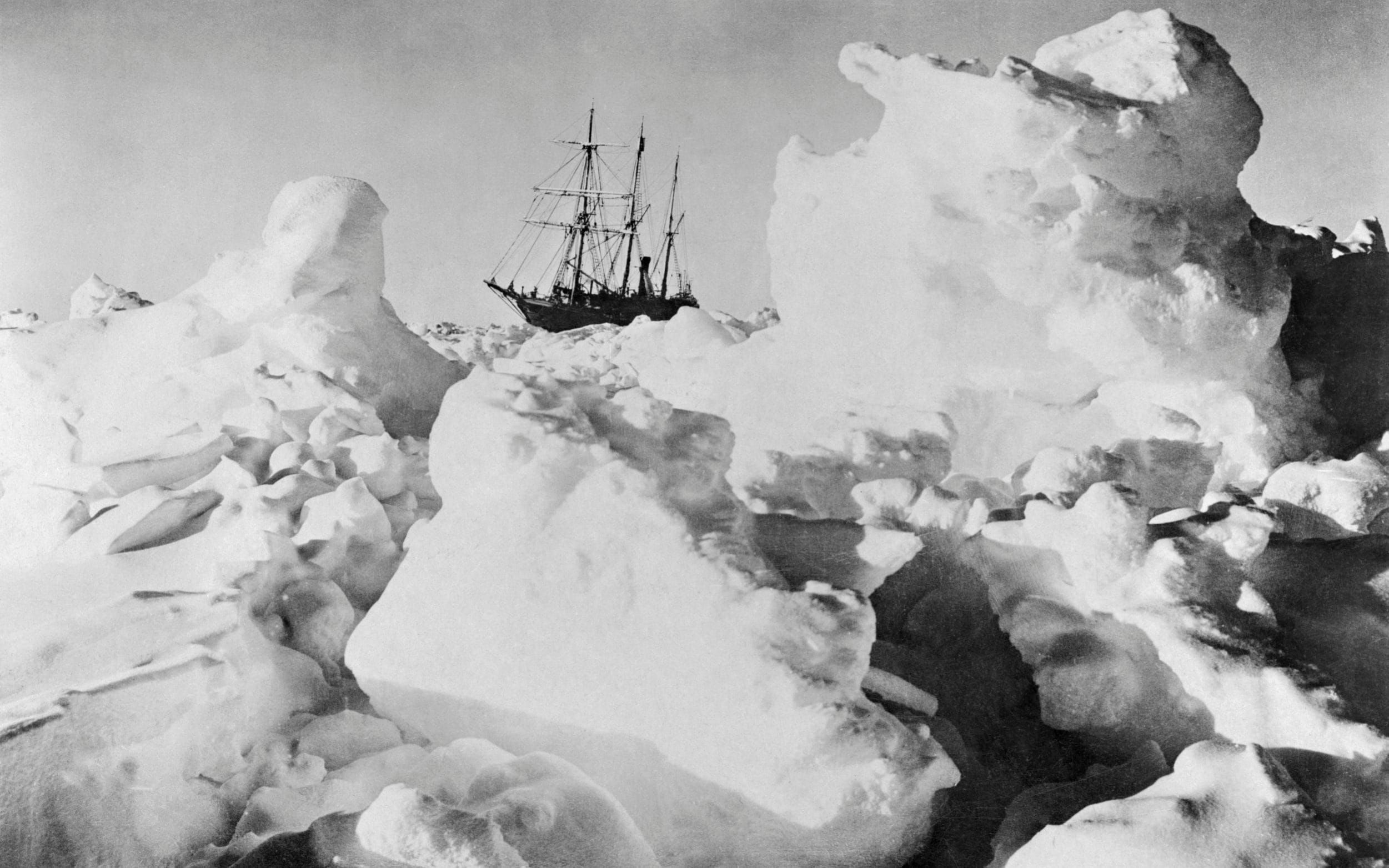MercoPress. South Atlantic News Agency
Endurance22 expedition nosed its course for Antarctica in search of the whereabouts of Shackleton's shipwreck
 Maritime archaeologist Mensun Bound, christened as ‘the Indiana Jones of the Deep’
Maritime archaeologist Mensun Bound, christened as ‘the Indiana Jones of the Deep’ Today, February 5th at 0700 GMT, a chunky, cherry-red ice breaker nosed its way out of Cape Town’s famous Table Bay, and shaped a course for Antarctica, 3000 nautical miles to the South West.
The ship is the South African flagged Agulhas II and on board are over a hundred people, two helicopters, two ice-drilling derricks and two uncrewed deep-ocean submersibles. It also carries the hopes of every Shackleton enthusiast the world over.
The expedition is called Endurance22. Their goal is nothing less than to beat their way through to the heart of the Weddell Sea pack and, once there, launch their submersibles to search for the wreck of Sir Ernest Shackleton’s Endurance that was crushed by pack ice and sank on 21 November, 1916, leaving Shackleton and 27 men alone on the ice in tents. The wreck of this iconic ship now lies on the abyssal plain of the Weddell Sea at a depth of 3000 m. According to maritime archaeologist Mensun Bound (christened by journalists ‘the Indiana Jones of the Deep’), it is the most unreachable archaeological site in the world, which makes this the greatest wreck hunt ever. He should know, now 68, he has been leading wreck excavations since his twenties.
The man at the helm is Captain Knowledge Bengu, a 41-year-old from Durban of many years Antarctic experience. Beside him is his long-time friend, the ship’s Ice Skipper Freddie Ligthelm from Cape Town, who oversaw the construction of the Agulhas II for his government ten years ago. As might be expected, he is very proud of the ship and delighted that this is the vessel that has been selected for the mission.
At the masthead, alongside the South African flag flutters that of the Falkland Islands. The project comes under the Falklands Maritime Heritage Trust, an organization that three years ago made world headlines when it found the Scharnhorst, the flagship of Admiral Graf von Spee that was sunk at the Battle of the Falkland Islands on 8 December 1914, the very day that the Endurance first encountered ice.
Bound is one of the four Trustees that include Bill Featherstone, Saul Pitaluga, and former Governor of the Falklands, Donald Lamont. ‘He’s the Chairman’, says Bound, ‘everything leads to and derives from him. You cannot begin to imagine the problems there have been in putting together an expedition of this scale and complexity at a time when the world has been brought to its knees by a pandemic. If there is a giant amongst us, it is Donald. He’s a Shackleton, when the rest of us were wobbling, he drove this whole thing through on no more than bloody-minded determination.’
For the Falklands, the so-called Gateway to Antarctica, this project is important. Scott was never in the Falklands, but Shackleton was there three times and even had a license to hunt seal around the archipelago. It was from the Falklands, on 31 May 1916, that Shackleton sent his first message to the outside world to let them know he was safe, but in need of help to rescue his men on Elephant Island. The telegram still survives in the Falklands National Archive, it reads:
31st May have arrived Falkland Islands Endurance crushed middle Weddell Sea October 27th 1915 drifted 700 miles on ice until April 9th 1916 landed Elephant Island 16th April left 24th April leaving 22 men in hole in ice cliff proceeded South Georgia with 5 men in 22 foot boat for help at time of leaving all well but urgent need immediate rescue
SHACKLETON

Sir Ernest Shackleton’s iconic ship, Endurance, sank crushed by ice in the Weddell Sea in November 1915.
‘It was from the Falklands on the despatch of this telegram’, says Bound, ‘that the Shackleton legend was born. It is important for the Islands and its museum that the Endurance is found. From some of the emails I have been getting I know that Kelpers [the sobriquet by which the Islanders are known] are right now all tanked up on Shackleton and watching everything from over our shoulder. I just hope we can deliver this one for them.’
Alongside Bound on the bridge are the other expedition principals, John Shears and Nico Vincent. If Bound, as Director of Exploration, has the responsibility for finding, recording and explaining the wreck, then Shears, as Expedition Leader, has the task of bringing all the components of this complex operation into step and working together. The third in the triumvirate is Nico Vincent from Marseilles in France. ‘Without him’, says Bound, ‘none of this would be possible. He is, if you like, our Captain of Sabertooths.’
The Sabertooths are the new search-and-survey vehicles that the team are depending upon for success. When asked how they work Bound starts talking about inertial navigation systems, Doppler velocity logs and laser point clouds. Basically, what it comes down to is that they are incredibly versatile robots that have 360⁰ manoeuvrability and are packed with the most advanced deep-water sensing technology in the world.
Ideally they will launch and recover the Sabertooths from the stern, but if this is not possible then, using their helicopters, they will leave the mother-ship and set up camps on the pack and drill holes through the floes using specially designed ice augers. This is where Jean Christophe Caillens, a retired French naval commander, comes in. He and Bound have a lot in common. They were both professional divers and while the former holds the record for the deepest dive ever made by the French Navy, the latter holds the record for the deepest hands-on, underwater, archaeological excavation there has ever been. On Endurance22 Caillens, or JC to his friends, is in charge of all back-deck and drilling operations. He and Bound have worked on many deepwater projects together. Bound regards Caillens as a teacher: ‘I have learned more from working with JC than with anyone else; he’s my subsea-tech guru.’
‘What I like about Endurance22’, continues Bound, ‘is that everybody on this team is an expert. Together they comprise a cadre of super-honed specialists, all very different in who they are and what they do, but all at the top of their game. I know this sounds a touch arrogant, but it reminds me a bit of the Moon Shot or the Manhattan Project in which an elite group of amazingly adroit individuals came together to solve a challenge that had a clearly defined finish-line. In our case it’s finding the Endurance.’
This is not the team’s first attempt at finding the Endurance. In 2019, using the same ship, they broke their way through to the search area and achieved a successful launch of their AUV (autonomous underwater vehicle) which was pre-programmed to cover 107 square nautical miles of seabed. The mission was going well and had covered over half the search box when the submersible failed to arrive for a routine check at a prescribed rendezvous spot.
Nobody knows what happened but Bound thinks that the most likely explanation is that it self-aborted its mission and came up beneath the ice, a dead zone that they could not reach by satellite position-fixing or their acoustic listening devices.
‘Back in 2019 the challenge was huge,’ says Bound, ‘we were heading into a lethal environment about which we then knew little. We were really pushing the boundaries; in the words of one of Shackleton’s favourite poets:
“We were the first that ever burst into that silent sea”
As in any big endeavour, when you are the first things will go wrong. We were a bit like that magician who thought he could walk through a wall. Remember what happened? He got a bloody nose. So it was with us.’
‘But we have learned from our mistakes. The submersible we used before’, continued Bound, ‘was autonomous, that is to say it was pre-programmed so that once it was released it was largely out of our control. The Sabertooths, by contrast will be tethered to the surface by a sheathed fibreoptic cable that will enable the operators to be in constant contact with the vehicle and also, if necessary, to pilot it. What this means is that we will be able to monitor the seabed in real time, in other words, see what the robot sees, and, if something goes wrong, we will have a three-dimensional fix on the vehicle and can send down the second Sabretooth to rescue it.’
Simple? We asked Chad Bonin who was also on the 2019 attempt and who only recently got back from Sabertooth training with the manufacturer in Sweden. ‘Not really’, he replied, ‘in fact it is incredibly complex, but at least we will have solutions that we did not have last time should something go wrong.’
We asked Bonin, who is from Louisiana, what the new expedition meant to him. ‘For me’, he replied, ‘it’s the second chance of a life time. Something I can tell my grandchildren about. You have to remember that Shackleton is as big in the States as he is in UK.’
Bound and Bonin are close friends. The have worked together for years on subsea projects all over the world. They were on the hunt for the lost Argentine submarine ARA San Juan and sunken ships of all kinds. ‘Sure have seen some strange geology and weird fish’, concluded Bonin in his distinctive Southern drawl.
So what does all this cost? When Bound was asked he became a little coy. All he will say is that it is privately funded, and then adds that Shackleton’s projects were also privately funded. And that just as Shackleton’s were, for his day, the largest privately funded Antarctic expeditions ever, so too is ours. ‘The trouble is’, he adds after a thoughtful pause, ‘you can throw as much money as you like at projects such as these, but, in the end, just as money can’t buy you love, it can’t buy you success. There is a large lap-of-the-Gods element in what we are doing.’
‘It’s a crap shoot’, adds Chad Bonin, who is standing beside him. ‘And right now’, quips Bound, ‘the dice are rolling.’




Top Comments
Disclaimer & comment rules-

Read all commentsGods speed
Feb 05th, 2022 - 09:07 pm 0Commenting for this story is now closed.
If you have a Facebook account, become a fan and comment on our Facebook Page!